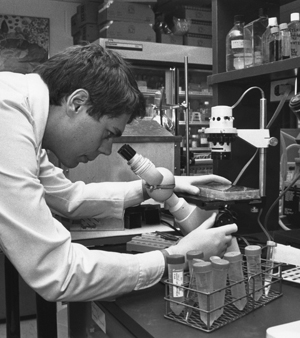AIDS at 30: A Relentless Search for Answers
A brief report on five gay men in Los Angeles with a rare and deadly form of pneumonia, published on June 5, 1981, sparked an ominous flash of recognition in a number of physicians and researchers in New York City.

They, too, were seeing such cases: young, previously healthy patients, nearly all gay men, who were appearing with swollen lymph nodes, pneumocystis carinii pneumonia, a rare skin cancer called Kaposi’s sarcoma, and other infections usually associated with weakened immune systems. Many of them were dying.
The report, published in the Centers for Disease Control and Prevention’s Morbidity and Mortality Weekly Report, was the first public acknowledgment of the condition that came to be known as AIDS.
Mathilde Krim, Ph.D., then a researcher at Memorial Sloan Kettering Cancer Center, was among the first to recognize the urgent need for a robust research effort. Faced with inertia from government officials, in 1983 she founded the AIDS Medical Foundation (AMF), which awarded its first research grants the following year.
“From day one, we decided to deal with the fundamental aspects of the AIDS problem,” said Dr. Krim. “We were mostly people coming from the scientific and medical worlds and we had specialized knowledge that we could exploit in the fight against AIDS.”
Harley Hackett, an AMF board member, also realized that that something terrible was unfolding. His friend Joseph Sonnabend, M.D., was treating gay men in New York’s Greenwich Village. “Unless doctors were working with gay male patients, they were not likely to see enough people with these symptoms to know how enormous it was going to be,” said Hackett. “But more and more people were getting sicker and sicker in different ways.”“Research Was Our Only Hope”
In 1985, AMF joined with the Los Angeles-based National AIDS Research Foundation to form the American Foundation for AIDS Research—amfAR. The Foundation would play a crucial role in funding early studies of HIV and later in the development of antiretroviral therapy. “It was a matter of life and death,” said Hackett. “The research was the only hope we had.”
The approval in 1987 of the first anti-HIV drug, AZT, was an important milestone. Still, AZT’s side effects were debilitating and the drug was only partly effective in combating the virus. The real turning point came in 1995 when the first protease inhibitors appeared, paving the way for triple combination therapy—the drug cocktails that revolutionized the treatment of HIV. “We called it the Lazarus syndrome,” said Jeffrey Laurence, M.D., who soon joined amfAR and is now the Foundation’s senior scientific consultant. “It was amazing—patients came back to life.”
Stigma and Fear
Even after scientists had established that HIV/AIDS could not be spread by casual contact, the disease continued to provoke fear and misinformation. The intense stigma attached to HIV, often fueled by homophobia, caused people to be shunned by friends, co-workers, and even family members, and led many to keep their status hidden. “People affected by AIDS were being neglected because of their sexual orientation,” explained Dr. Krim. “Gay men were accused of creating the problem.”

In fact, anyone who came into contact with an HIV-positive person could be shunned. “At Rockefeller University, where I worked, the mailmen stopped bringing my mail to the lab,” said Dr. Laurence. “The secretaries wouldn’t let me put my coat in the office; they wanted me to put it in the hall. They were afraid I was carrying something.”
Early advocacy efforts by amfAR and other AIDS organizations were aimed at ensuring that people living with the virus enjoyed the same rights as their fellow citizens, including the right to treatment and care. Dame Elizabeth Taylor was an early and vocal advocate, and her outspokenness on Capitol Hill and in the media helped bring AIDS out of the shadows.
“She saw this terrible disease, and she was angered by the fact that nobody was doing anything about it,” said amfAR CEO Kevin Robert Frost. “She just stepped right into the breach.” Together with Dr. Krim, Dame Elizabeth lobbied for increased federal funds for research, prevention, education, treatment, and care.
The End of AIDS?
When the first AIDS cases were reported, no one knew what was causing it, how it was being transmitted, or how to prevent and treat it. Thirty years later, people with HIV/AIDS are living longer and healthier lives thanks to antiretroviral therapy, HIV-positive mothers are safely delivering babies who are HIV-negative, and new prevention strategies are helping to reduce the number of new infections.
Yet, as AIDS enters its fourth decade, more than 33 million people are living with the virus and 25 million people have died of AIDS-related illnesses. While access to treatment has greatly increased, less than half of those in need are receiving it. And for every person put on treatment, two to three more become infected with HIV.
“We’ve come a long way on treatment and we’re seeing some advances in prevention,” says amfAR Chairman Kenneth Cole. “But we’re not yet where we need to be. We need to find a cure, and that’s where we’re targeting our investments.”
“We’re closer [to a cure] than people think,” says Frost, “and with the right financial investment, we can get there. The real question in my mind is, are we going to find the money to do it?
Share This:
